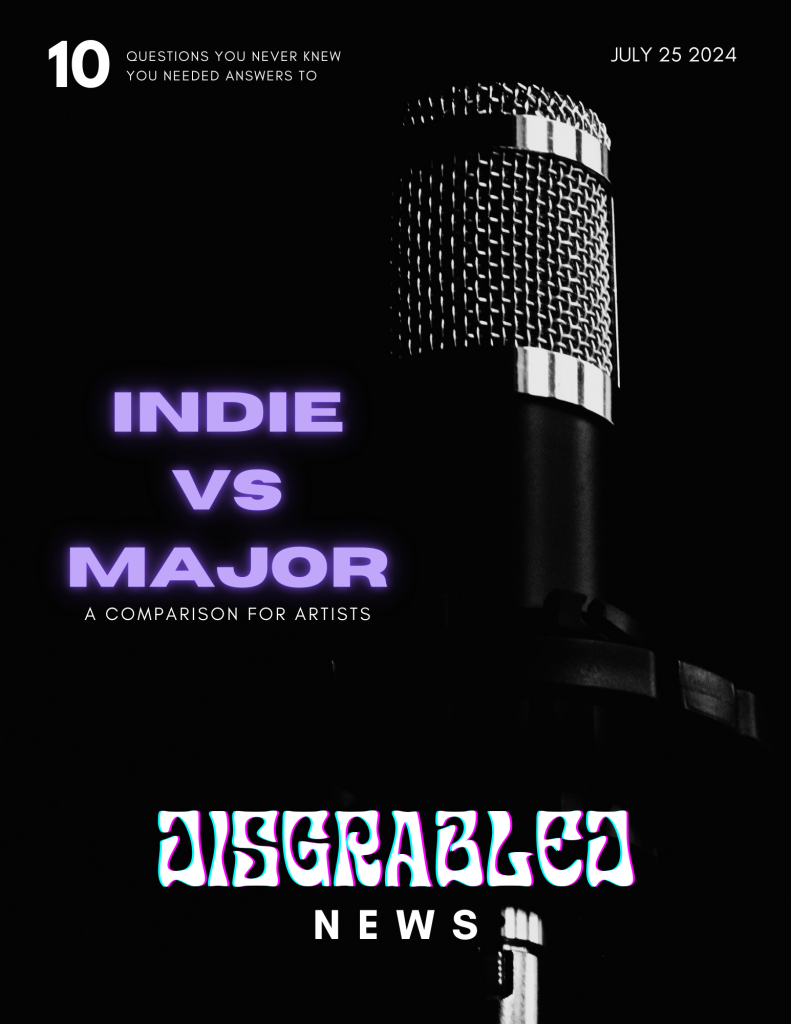
Welcome to Disgrabled News!
In the ever-evolving landscape of the music industry, navigating the path to success can be challenging for artists. Today, we dive into the contrasting strategies between independent record labels like Disgrabled Records and major labels often associated with the “big three” – Universal Music Group, Sony Music Entertainment, and Warner Music Group.
The Independent Advantage.
Independent record labels prioritize artistic freedom and personalized attention. At Disgrabled Records, artists have the liberty to explore their creative visions without the constraints often imposed by corporate interests. The focus is on nurturing individual talents and fostering a close-knit community of like-minded creatives.
– Creative Control:
Independent artists retain more control over their music, from songwriting and production to marketing strategies. This autonomy allows for authentic expression and innovative soundscapes.
– Revenue Streams:
Independent labels typically offer more favorable revenue splits, ensuring artists receive a larger share of their earnings. This financial transparency helps build trust and long-term partnerships.
– Agility and Flexibility:
Smaller teams mean quicker decision-making and adaptability. At Disgrabled Records, we can pivot strategies rapidly to respond to market trends or the unique needs of our artists.
The Major Label Machine.
On the other hand, major labels come with their own set of advantages, primarily driven by their vast resources and established networks.
– Marketing Muscle:
Major labels have significant budgets for marketing and promotion, enabling widespread reach and exposure. Their connections with media outlets, streaming platforms, and radio stations can catapult an artist’s career on a global scale.
– Production Quality:
Access to top-tier producers, songwriters, and recording studios ensures high production quality. The resources available to major labels can enhance an artist’s sound to meet commercial standards.
– Distribution Power:
Major labels have extensive distribution networks, ensuring music is available in every corner of the world. Their established relationships with retailers and digital platforms facilitate seamless distribution.
Finding the Right Fit.
The choice between an independent and a major label depends on an artist’s career goals and values. At Disgrabled Records, we believe in empowering artists to make informed decisions. While major labels offer unparalleled resources, the independence and personal touch of an independent label can provide a fulfilling and profitable path.
In conclusion, the music industry landscape is vast and varied. The path to success is not one-size-fits-all, and Disgrabled Records is here for you whether you prefer freedom, or corporate level results.
Stay tuned for more insights and updates from Disgrabled News!
10 questions you never knew you needed answers to
1. What are the primary differences in creative control? Indie labels often offer more creative freedom, allowing artists to truly express their vision without heavy commercial constraints.
2. How do funding and budget allocations differ? Major labels tend to have bigger budgets for production, marketing, and tour support, whereas indie labels might have more limited financial resources but invest more selectively.
3. What’s the level of personal attention artists receive? Indie labels usually provide more personalized attention, fostering close relationships with each artist.
4. How do distribution channels compare? Major labels typically have wider and more established distribution networks, ensuring greater reach, while indie labels might rely more on grassroots and digital-focused distribution.
5. What are the pros and cons of signing with a major label in terms of exposure? Major labels can provide massive exposure through their extensive resources, but the competition is fierce, and not all artists get the spotlight.
6. How do royalties and profit sharing differ? Indie labels often offer more favorable royalty rates and profit-sharing arrangements compared to the often complex and sometimes less favorable deals from major labels.
7. What’s the impact on an artist’s branding and image? Major labels might try to mold an artist’s image to fit market trends, whereas indie labels often support a more authentic and organic artist brand.
8. How do marketing strategies differ? Major labels might employ big-budget campaigns and traditional media, while indie labels often use innovative, niche-targeted, and grassroots marketing strategies.
9. What are the opportunities for artistic collaborations? With indie labels, artists might have more opportunities for unique collaborations, often working with a diverse range of on-the-rise talents.
10. How does the long-term career trajectory compare? Artists on indie labels might build a more loyal, niche fanbase with steady growth, while those on major labels can face rapid peaks but also sharp declines based on market trends.